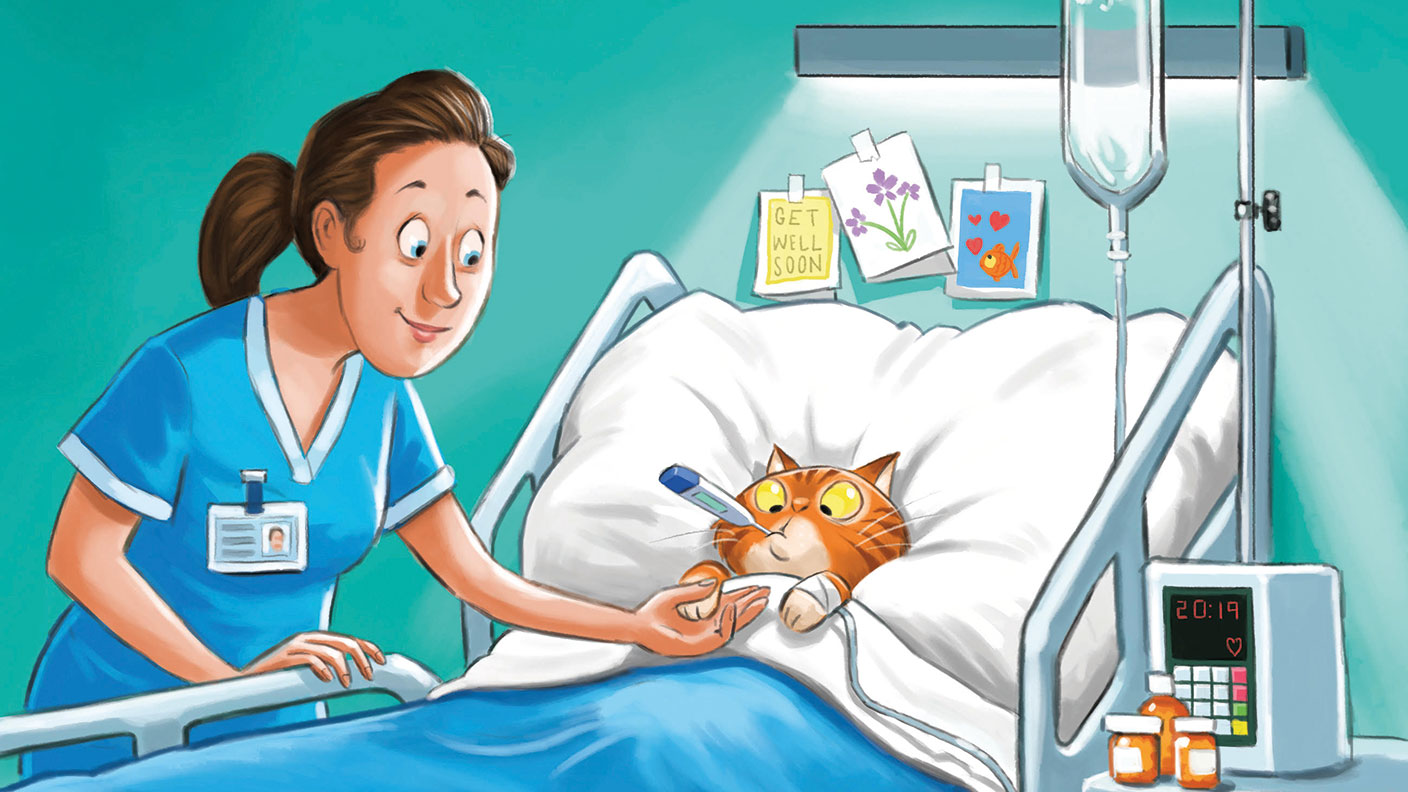Veterinary medicine stocks: the firms keeping your pet healthy
Pet ownership has grown due to the pandemic. That’s good news for animal health stocks, says Dr Mike Tubbs


One of the surprising consequences of Covid-19 was an increase in pet ownership, as families spent more time at home and felt that they could look after a new dog or cat. Around 11% of UK households gained a new pet between March 2020 and March 2021, according to a survey by the Pet Foods Manufacturers’ Association. Another 10% were planning to do so. Among young adults aged 24-35, 35% had already become or intended to become pet owners.
This is a continuation of a long-term trend towards greater pet ownership – and not just in Britain. In the US, the percentage of households owning a pet rose from 56% in 1988 to 66% in 2023, according to the American Pet Association. Dogs and cats are by far the most common pets in both the US and UK.
That trend is very good news for veterinary pharmaceutical companies, who supply everything from annual pet vaccinations to the drugs needed when animals get ill. Today, the veterinary pharmaceutical market is only about 2% to 2.5% of the size of that for human pharmaceuticals – but it is growing much more quickly. The global market is expected to grow from $31bn in 2020 to $64bn in 2025 and $126bn in 2030, a compound annual growth rate of 15%. North America is unsurprisingly the largest region, accounting for roughly 45% of global sales.
MoneyWeek
Subscribe to MoneyWeek today and get your first six magazine issues absolutely FREE

Sign up to Money Morning
Don't miss the latest investment and personal finances news, market analysis, plus money-saving tips with our free twice-daily newsletter
Don't miss the latest investment and personal finances news, market analysis, plus money-saving tips with our free twice-daily newsletter
Big pharma spins off animal health
Veterinary medicine firms often used to be divisions of large pharmaceutical companies, since many animal medicines are just repurposed human drugs that have been tested on target animals to check safety and identify the correct dose. However, in recent years many of these animal health divisions have been spun-off as separate listed companies or restructured or swapped. Pfizer spun-off its animal health activities into a new company called Zoetis in 2012. Zoetis – which is the largest animal health company in the world, with turnover of $7.8bn in 2021 – now has a market cap of $89bn compared with Pfizer’s $270bn.
In 2018, Eli Lilly spun-off its animal health activities as a separate company called Elanco. It had previously acquired Novartis’s animal health division in 2014 and then bought Bayer’s animal health division in 2020. The enlarged Elanco now has sales of $4.8bn and a market cap of $12.2bn. Boehringer Ingelheim, which is not listed, carried out a swap with Sanofi in 2016, with Sanofi taking Boehringer’s consumer healthcare business and Boehringer getting Sanofi’s animal health business: it now has $4.6bn in animal-health revenues. The main exception among the biggest players is Merck, which still has $5.6bn in animal health revenues – 11.5% of its total sales of $48.7bn.
The rest of the global top ten include Ceva Sante Animale ($1.4bn in sales, unlisted and majority owned by management and employees), Virbac ($1.06bn), Philbro Animal Health ($833m), Dechra Pharmaceuticals ($827m), Kyoritsu Seiyaku ($545m, unlisted and the largest animal health company in Asia) and Vetoquinol ($483m). These ten companies account for roughly 70% of the market. Seven of the ten companies are listed, but since Merck’s performance depends primarily on human pharmaceuticals, we can exclude it. Conversely, investors should also look at Idexx Laboratories, a non-pharmaceutical firm that gets most of its $3.2bn revenue from diagnostic products and software for veterinary practices. These diagnostic products range from kidney-function testing to cell and antigen testing, and it also provides tests of water and milk quality for livestock and poultry.
The firms most geared to the pet market
Animal health encompasses both livestock and pet products. The livestock pharmaceutical market is slightly larger (54% of the total in 2019), but the pet market has a higher growth rate and we can expect the pandemic trends to increase that rate further.
We can therefore look at the share of revenue that each company gets from pet pharmaceuticals in 2020, plus the proportion of revenue from the US market – both the biggest and one of the most advanced for new treatments. We also want to consider how much each company spends on research and development (R&D) as a percentage of sales if that information is available, since this indicates the amount of resources going into developing new products.
• Zoetis gets 60% of its revenue from pets and 39% from livestock (the balance of 1% comes from contract manufacturing and human health). The US market accounts for 62% of sales. R&D is 6.5% of sales and includes work on several monoclonal antibody drugs.
• Elanco has 49% of revenue each from pets and livestock (plus 2% contract manufacturing) North America is 48% of sales and R&D is 7.7% of sales.
• Idexx has 88% of revenues from pets, with 62.5% from the US. R&D is 5.2% of sales.
• Virbac derives 59% of revenue from pets with 41% from livestock. Only 13% of sales are in North America. R&D is 1.6% of sales.
• Philbro does not provide a pets/livestock split between sales or give a figure for R&D but states that 59% of sales are from the US.
• Dechra derives 80% of revenue from pets, 13% from livestock and the remainder mainly from nutritional products. The US accounts for 34% of sales and R&D is 5.3% of sales.
• Vetoquinol has 60% of revenue from pets and 40% from livestock. The Americas accounts for 35% of sales. R&D is only 0.7% of sales.
In addition to these companies, there are firms such as PetIQ that concentrate on over-the-counter animal health and wellness. These less R&D-intensive products include oral flea, tick and calming treatments, food supplements and dental chews.
Award-winning new veterinary drugs
Understanding the status of R&D work at animal health firms is not straightforward. Unlike human pharmaceutical companies, veterinary pharmaceutical companies do not publish new drug pipelines so it is much harder to see if they have blockbuster new drugs on the way that could generate big increases in sales.
However, studying awards given to animal health companies gives an indication of which companies have come up with ground-breaking new drugs in the past few years. For example, IHS Markit is a leading source of information and insight for many different industries. It gives annual animal health awards for the best newly launched pet product each year. In 2020, it gave the award to Zoetis’s Simparica Trio which is a once-monthly triple combination medication for dogs at risk from external and internal parasitic infections.
In 2021 the award also went to Zoetis for Librela, which is the first ever monoclonal antibody treatment to alleviate osteoarthritic pain in dogs. Librela was approved in Europe (UK, EU and Switzerland) in April 2021. A monthly injection controls pain and increases mobility and is said to have a low level of adverse effects. Librela is a new alternative to non-steroidal anti-inflammatory drugs (NSAIDs), which often have serious side effects.
We tried Librela on our 11-year-old Saint Bernard who has osteoarthritis and could not tolerate NSAIDs. It was very effective for the first two monthly injections. However, the beneficial effects reduced for later injections, with the sixth injection having almost no benefit, so for some breeds and some types of osteoarthritis, effectiveness drops off.
The Veterinary Marketing Association also gives a Best New Veterinary Product of the Year award, based on research among veterinarians by the award sponsors CM Research, a specialist veterinary and pet-market research company that conducts research on veterinary pharmaceuticals across more than 20 countries. The latest award was given to Elanco for Galliprant, a new treatment for canine osteoarthritis that has less adverse effects on liver and kidneys than other NSAIDs.
The previous year’s award was won by Cytopoint, the first ever monoclonal antibody treatment in the veterinary industry. It treats canine dermatitis and is made by Zoetis. The runners-up were Merck and Dechra (with Prevomax for treating nausea and vomiting in dogs and cats).
The examples of Galliprant and Librela emphasise how serious osteoarthritis is for older dogs. New treatments for this and other conditions are urgently needed, which illustrates why R&D investment is no less important in animal health than in human health. The four companies mentioned above are all putting a substantial amount back into R&D, and that’s reflected in the most compelling investment choices below.
Four top plays on pet health
The leading companies have differing growth rates, but most are fairly high. Revenue growth rates for the three years from 2018 to 2021 are Zoetis 33.6%, Elanco 55%, Idexx 37.5%, Virbac 22%, Philbro 1.6% and Dechra 49.3%. Vetoquinol grew at 21.4% from 2017 to 2020. Elanco’s growth was boosted by the Bayer deal and Dechra’s by several acquisitions.
The price/earnings (p/e) ratios are also correspondingly high, led by Zoetis (35.4 for 2022 and 31.6 for 2023), Idexx (53.2 and 45.8) and Dechra (48.9 and 44.6). These reflect their higher growth rates. Others are lower, though few are actually low: Elanco is on 21.2 (2022) and 17.4 (2023), Virbac on 31.2 (2022) and 28 (2023), Philbro is on 15.1 (2022) and 15.4 (2023) and Vetoquinol on 23.5 (2022) and 21.8 (2023).
There are two ways of assessing higher p/e ratios. The first is to look at the price/earnings/growth (PEG) ratio for a company – that is the p/e ratio divided by the earnings growth rate. A PEG of one or less usually denotes good value. Looking at Zoetis, its earnings per share (EPS) grew by 24.7% from 2020 to 2021. With a 2021 p/e of 39, the PEG is 1.6 – quite high.
The second method is to estimate earnings growth over five years and see what the p/e would be. Zoetis is by far the largest veterinary pharma company so it is likely to grow at least as fast as the market. Taking the forecast compound annual growth rate of 15% for ten years, Zoetis’s 2021 EPS of $4.67 would grow to $9.40 after five years. At the current share price of $182.8, that would put it on a forecast p/e of 19.4. The question is whether the market would still grant a p/e of, say, 35 to Zoetis in 2026, since 15% per year growth is forecast to continue. If so, the share price would rise to $330-plus, which gives a reasonable profit over five years.
A cautious investor might invest in Zoetis (NYSE: ZTS) at a recent price of $188 as the market leader. Elanco (NYSE: ELAN) at $25.7, has the highest R&D/sales ratio, a reasonable p/e and decent revenue growth. Risk-tolerant investors might consider Idexx (Nasdaq: IDXX) at $504 and Dechra (LSE: DPH) at 3,842p. These two firms have the highest proportion of higher-growth pet sales, R&D/sales ratios above 5% and strong revenue growth. Dechra’s interim results last month showed operating profit up 15.9%.
Get the latest financial news, insights and expert analysis from our award-winning MoneyWeek team, to help you understand what really matters when it comes to your finances.
Highly qualified (BSc PhD CPhys FInstP MIoD) expert in R&D management, business improvement and investment analysis, Dr Mike Tubbs worked for decades on the 'inside' of corporate giants such as Xerox, Battelle and Lucas. Working in the research and development departments, he learnt what became the key to his investing; knowledge which gave him a unique perspective on the stock markets.
Dr Tubbs went on to create the R&D Scorecard which was presented annually to the Department of Trade & Industry and the European Commission. It was a guide for European businesses on how to improve prospects using correctly applied research and development.
He has been a contributor to MoneyWeek for many years, with a particular focus on R&D-driven growth companies.
-
 Rachel Reeves's Autumn Budget: What it means for the UK
Rachel Reeves's Autumn Budget: What it means for the UKOpinion A directionless and floundering government has ducked the hard choices at the Autumn Budget, says Simon Wilson
-
 The reinvention of the high street – and how to invest
The reinvention of the high street – and how to investThe high street brands that can make shopping and leisure an enjoyable experience will thrive, says Maryam Cockar
-
 The consequences of the Autumn Budget – and what it means for the UK economy
The consequences of the Autumn Budget – and what it means for the UK economyOpinion A directionless and floundering government has ducked the hard choices at the Autumn Budget, says Simon Wilson
-
 Reinventing the high street – how to invest in the retailers driving the change
Reinventing the high street – how to invest in the retailers driving the changeThe high street brands that can make shopping and leisure an enjoyable experience will thrive, says Maryam Cockar
-
 8 of the best houses for sale with electric vehicle charging
8 of the best houses for sale with electric vehicle chargingThe best houses for sale with electric vehicle charging – from a converted World War II control tower in Scotland, to a Victorian country house in Cumbria
-
 Big Short investor Michael Burry closes hedge fund Scion Capital
Big Short investor Michael Burry closes hedge fund Scion CapitalProfile Michael Burry rightly bet against the US mortgage market before the 2008 crisis. Now he is worried about the AI boom
-
 The global defence boom has moved beyond Europe – here’s how to profit
The global defence boom has moved beyond Europe – here’s how to profitOpinion Tom Bailey, head of research for the Future of Defence Indo-Pac ex-China UCITS ETF, picks three defence stocks where he'd put his money
-
 Profit from a return to the office with Workspace
Profit from a return to the office with WorkspaceWorkspace is an unloved play on the real estate investment trust sector as demand for flexible office space rises
-
 New frontiers: the future of cybersecurity and how to invest
New frontiers: the future of cybersecurity and how to investMatthew Partridge reviews the key trends in the cybersecurity sector and how to profit
-
 An “existential crisis” for investment trusts? We’ve heard it all before in the 70s
An “existential crisis” for investment trusts? We’ve heard it all before in the 70sOpinion Those fearing for the future of investment trusts should remember what happened 50 years ago, says Max King
